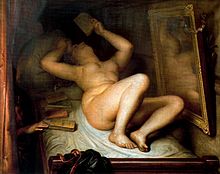User:Kwesthoven/sandbox
Women reading in art[edit]

The act of women reading is commonly depicted in art, with images appearing as early as the 14th century.[1] Viewers are often exposed to a private, personal moments through these works. In the piece Reading Woman (c.1660) by Pieter Janssans Elinga, for example, we see reading as an intimate and introspective activity.
Beyond the exchange of ideas between author and reader, scholar James Conlon describes reading as an intimate and erotic subject, through the captivating book that touches and holds the reader's attention, and offers tactile pleasure in weight. As a result, then, the image of a woman reading becomes one of sexual subversion, and a source of fear for the male viewer or artist.[1] In Western, patriarchal societies, Conlon argues, the act of reading takes a woman out of subservient role and into a context where personal pleasure, knowledge, and enjoyment is literally in her hands.[1] Possibly in effort to counter this threatening prospect, male artists have portrayed women readers in various categorical ways.
Depictions of Woman Readers:[edit]

During the 19th century, for example, amidst a golden age for reading, concerns emerged about women's reading as jeopardizing marital and familial structures.[2] Drawings and illustrations of time reflected this fear that women would be seduced by books and neglect their domestic duties. Other images implied the danger in tempting women with books as explicitly linked to their sexuality, like in Antoine Wiert'sThe Reader of Novels (c.1853), where the figure of the devil literally supplies the female subject with pleasurable reading material.[2]

In Dutch Golden Age painting, female readers were depicted as part of the genre of the everyday, usually engaged with letters. Vermeer, for example, created numerous works around this subject, including A Woman in Blue Reading a Letter and Girl Reading a Letter at an Open Window. Despite this apparent acceptance of woman readers, scholars have determined that the letters including in Dutch painting were almost exclusively love letters.[3] As Conlon argues, the self-relective act of reading becomes conflated in these depictions with distraction and longing for someone - presumably a male lover - ultimately undermining the subjectivity of the woman reader.[1]
Male artists have also depicted women readers within pastoral settings, like in Monet's Springtime, perhaps in an attempt to tame or domesticate the otherwise wild act of reading.[1]

Female artists and the subject of reading:[edit]
Interestingly, female artists have also been drawn to the subject of women readers. These artists depictions of reading greatly differ from their male counterparts, demonstrating the complexity of the topic. Mary Cassat's piece, Family Group Reading, is a powerful representation of women readers who demonstrate subjectivity and serious literary engagement. All three are fixated on the text, and Cassat may be emphasizing that reading comes just as naturally to women as motherhood, by painting the young girl encircled by the woman's arms and drawn literally into the book.[1]
Suggestions on the 'Talk' page: Judith Slaying Holofernes (Artemisia Gentileschi)[edit]
- Garrard's autobiographical interpretation is heavily represented. More diversified sources could be beneficial. Kwesthoven (talk) 00:16, 27 February 2017 (UTC)
- Discussion of Cristofano Allori's piece could be more clearly explained in connection to Gentileschi, otherwise this information seems distracting. Kwesthoven (talk) 00:16, 27 February 2017 (UTC)
Vermeer's Woman in Blue Reading A Letter[edit]
Although the woman's loose clothing may be suggestive, pregnancy was very rarely depicted in art during this period.[4]
The very action of letter-reading reflects a thematic pattern throughout Vermeer's works, as the quotidian, private moment becomes revealing of the human condition.[5]
 | This is a user sandbox of Kwesthoven. You can use it for testing or practicing edits. This is not the sandbox where you should draft your assigned article for a dashboard.wikiedu.org course. To find the right sandbox for your assignment, visit your Dashboard course page and follow the Sandbox Draft link for your assigned article in the My Articles section. |
- ^ a b c d e f Conlon, James (2005). "Men Reading Women Reading: Interpreting Images of Women Readers" (PDF). Frontiers: A Journal of Women Studies. 26 (2): 37–58. doi:10.1353/fro.2005.0021. JSTOR 4137395. S2CID 143534851 – via JSTOR.
- ^ a b Jack, Belinda (2012). The Woman Reader. Yale University Press. pp. 228–256.
- ^ "Painting in the Dutch Golden Age: A Profile of the Seventeenth Century" (PDF). National Gallery of Art, Washington. 2007. Retrieved 3/6/2017.
{{cite web}}: Check date values in:|access-date=(help) - ^ De Winkel, Marieke (1998). "The Interpretation of Dress in Vermeer's Paintings" (PDF). Studies in the History of Art. 55: 326–339. JSTOR 42622616. Retrieved 2017-02-27.
- ^ Baker, Christopher. "Vermeer, Jan". Oxford Art Online. Retrieved February 27, 2017.
